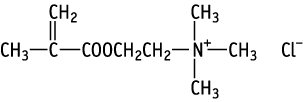

A single dose oral toxicity test of (methacryloyloxyethyl)trimethylammonium chloride revealed an LD50 value of more than 2000 mg/kg for both sexes.
(Methacryloyloxyethyl)trimethylammonium chloride was studied for oral toxicity in rats in a 28-day repeat dose toxicity test at doses of 0, 50, 150 and 500 mg/kg. However, the toxicity profile of the test substance could not thereby be clarified. Thus, a supplementary test was carried out using the limiting dose, 1000 mg/kg, stated in the test guidelines. No deaths were observed in either sex. Repeated administration at 1000 mg/kg caused transient decrease in fecal excretion in some animals of both sexes during administration period, and slightly inhibited the body weight gain. However, the examinations revealed no evident functional and morphological alteration or signs of toxicity thought to have relevance to the test substance administered. Thus, the NOEL for the 28-day repeat dose oral toxicity test of (methacryloyloxyethyl)trimethylammonium chloride is considered to be 1000 mg/kg/day for males and females.
Genotoxicity of (methacryloyloxyethyl)trimethylammonium chloride was studied by reverse mutation test in bacteria and chromosomal aberration test in cultured Chinese hamster lung (CHL/IU) cells.
(Methacryloyloxyethyl)trimethylammonium chloride was not mutagenic in Salmonella typhimurium TA100, TA1535, TA98, TA1537 and Escherichia coli WP2 uvrA, with or without an exogenous metabolic activation system.
(Methacryloyloxyethyl)trimethylammonium chloride induced structural chromosomal aberrations in CHL/IU cells after continuous treatment without an exogenous metabolic activation system.
| Purity | : | 78.1 %(water solution) |
| Test species/strain | : | Rat/Crj:CD(SD)IGS |
| Test method | : | OECD Test Guideline 401 |
| Route | : | Oral(gavage) |
| Doses | : | Males, 1000, 2000 mg/kg Females, 2000 mg/kg |
| Number of animals/group | : | Males, 5; females, 5 |
| Vehicle | : | Water for injection |
| GLP | : | Yes |
Test results:
The LD50 value was concluded to be more than 2000 mg/kg for both sexes.
| Purity | : | 78.1 %(water solution) |
| Test species/strain | : | Rat/Crj:CD(SD)IGS |
| Test method | : | Guideline for 28-Day Repeated Dose Toxicity Test in Mammalian Species (Chemical Substances Control Law of Japan) |
| Route | : | Oral(gavage) |
| Doses | : | First test: 0(vehicle), 50, 150, 500 mg/kg/day Additional test: 0(vehicle), 1000 mg/kg/day |
| Number of animals/group | : | First test: Males, 10; females, 10(0, 500 mg/kg) Males, 5; females, 5(50, 150 mg/kg) Additional test: Males, 10; females, 10(0, 1000 mg/kg) |
| Vehicle | : | Water for injection |
| Administration period | : | Males and females, 28 days |
| Terminal kill | : | Males and females, on days 29 and 43 |
| GLP | : | Yes |
Test results:
Thus, the NOEL for the 28-day repeat dose toxicity is considered to be 1000 mg/kg/day for males and females.
| Purity | : | 78.1 % |
| Test species/strain | : | Salmonella typhimurium TA100, TA1535, TA98, TA1537, Escherichia coli WP2 uvrA |
| Test method | : | Guidelines for Screening Mutagenicity Testing of Chemicals(Chemical Substances Control Law of Japan) and OECD Test Guideline 471 |
| Procedures | : | Pre-incubation method |
| Solvent | : | DMSO |
| Positive controls | : | -S9 mix; 2-(2-Furyl)-3-(5-nitro-2-furyl)acrylamide (TA100, TA98, WP2 uvrA), Sodium azide (TA1535) and 9-Aminoacridine (TA1537) +S9 mix; 2-Aminoanthracene (all strains) |
| Doses | : | -S9 mix; 0, 313, 625, 1250, 2500, 5000 μg/plate +S9 mix; 0, 313, 625, 1250, 2500, 5000 μg/plate |
| S9 | : | Rat liver, induced with phenobarbital and 5,6-benzoflavone |
| Plates/test | : | 3 |
| Number of replicates | : | 2 |
| GLP | : | Yes |
Test results:
Genotoxic effects:
Salmonella typhimurium TA100, TA1535, TA98, TA1537
| + | ? | - | |
| Without metabolic activation: | [ ] | [ ] | [*] |
| With metabolic activation: | [ ] | [ ] | [*] |
Escherichia coli WP2 uvrA
| + | ? | - | |
| Without metabolic activation: | [ ] | [ ] | [*] |
| With metabolic activation: | [ ] | [ ] | [*] |
| Purity | : | 78.1 % Type of cell used : Chinese hamster lung (CHL/IU) cells |
| Test method | : | Guidelines for Screening Mutagenicity Testing of Chemicals(Chemical Substances Control Law of Japan) and OECD Test Guideline 473 |
| Solvent | : | DMSO |
| Positive controls | : | -S9 mix; 1-Methyl-3-nitro-1-nitrosoguanidine +S9 mix; 3,4-Benzo[a]pyrene |
| Doses | : | -S9 mix(6 hr short-term treatment); 0, 525, 1050, 2100 μg/mL +S9 mix(6 hr short-term treatment); 0, 525, 1050, 2100 μg/mL -S9 mix(24 hr continuous treatment); 0, 525, 1050, 2100 μg/mL |
| S9 | : | Rat liver, induced with phenobarbital and 5,6-benzoflavone |
| Plates/test | : | 2 |
| GLP | : | Yes |
Test results:
Cytotoxicity was not observed in any treatment group.
| Lowest concentration producing cytogenetic effects in vitro: | ||
| Without metabolic activation (24 hr continuous treatment) | : | 1050 μg/mL(clastogenicity) |
Genotoxic effects:
| clastogenicity | polyploidy | |||||
| + | ? | - | + | ? | - | |
| Without metabolic activation: | [*] | [ ] | [ ] | [ ] | [ ] | [*] |
| With metabolic activation: | [ ] | [ ] | [*] | [ ] | [ ] | [*] |
| 1) | The tests were performed by the Hatano Research Institute, Food and Drug Safety Center, 729-5 Ochiai, Hadano-shi, Kanagawa, 257-8523, Japan. Tel +81-463-82-4751 Fax +81-463-82-9627 |
| 2) | The tests were performed by the Research Institute for Animal Science in Biochemistry and Toxicology, 3-7-11 Hashimotodai, Sagamihara-shi, Kanagawa 229-1132, Japan. Tel +81-42-762-2775 Fax +81-42-762-7979 |